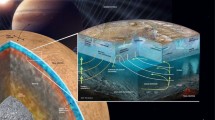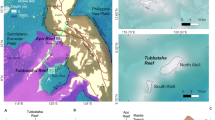Abstract
Thirty-three new measurements on the seaward slope and outer rise of the Japan Trench along a parallel of 38°45′N revealed the existence of high heat flow anomalies on the subducting Pacific plate, where the seafloor age is about 135 m.y.. The most prominent anomaly with the highest value of 114 mW/m2 is associated with a small mound on the outer rise, which was reported to be a kind of mud volcano. On the seaward slope of the trench, heat flow is variable: high (70–90 mW/m2) at some locations and normal for the seafloor age (about 50 mW/m2) at others. The spatial variation of heat flow may be related to development of normal faults and horst/graben structures due to bending of the Pacific plate before subduction, with fluid flow along the fault zones enhancing the vertical heat transfer. Possible heat sources of the high heat flow anomalies are intra-plate volcanism in the last several million years like that discovered recently on the Pacific plate east of the Japan Trench.







Similar content being viewed by others
References
Davis EE (1989) Thermal aging of oceanic lithosphere. In: Wright JA, Louden KE (eds) CRC handbook of seafloor heat flow. CRC, Boca Raton, pp 145–167
Davis EE, Wang K, He J, Chapman DS, Villinger H, Rosenberger A (1997) An unequivocal case for high Nusselt number hydrothermal convection in sediment-buried igneous oceanic crust. Earth Planet Sci Lett 146:137–150
Fisher AT, Von Herzen RP (2005) Models of hydrothermal circulation within 106 Ma seafloor: constraints on the vigor of fluid circulation and crustal properties, below the Madeira Abyssal Plain. Geochem Geophys Geosyst 6:Q11001. doi:10.1029/2005GC001013
Foucher JP, Le Pichon X, Lallemant S, Hobart MA, Henry P, Benedetti M, Westbrook GK, Langseth MG (1990) Heat flow, tectonics, and fluid circulation at the toe of the Barbados Ridge accretionary prism. J Geophys Res 95:8859–8867
Hasebe K, Fujii N, Uyeda S (1970) Thermal processes under island arcs. Tectonophysics 10:335–355
Henry P, Le Pichon X, Lallemant S, Lance S, Martin JB, Foucher J-P, Fiala-Medioni A, Rostek F, Guilhaumou N, Pranal V, Castree M (1996) Fluid flow in and around a mud volcano field seaward of the Barbados accretionary wedge: results from Manon cruise. J Geophys Res 101:20297–20323
Hirano N, Kawamura K, Hattori M, Saito K, Ogawa Y (2001) A new type of intra-plate volcanism; young alkali-basalts discovered from the subducting Pacific Plate, northern Japan Trench. Geophys Res Lett 28:2719–2722
Hirano N, Takahashi E, Yamamoto J, Abe N, Ingle SP, Kaneoka I, Hirata T, Kimura J, Ishii T, Ogawa Y, Machida S, Suyehiro K (2006) Volcanism in response to plate flexure. Science 313:1426–1428
Kinoshita M, Goto S, Hamamoto H, Yamano M (2003) Heat flow distribution and thermal regime across the Nankai accretionary complex. Eos Trans AGU 84(46), Fall meet suppl abstract, T42C-06
Kisimoto K (2000) Combined bathymetric and topographic mesh data: Japan250m grd. Geological Survey of Japan open file report no. 353, Geological Survey of Japan
Kobayashi K (ed) (1991) Preliminary report of the Hakuho Maru cruise KH 90-1. Ocean Res Inst Univ Tokyo, Tokyo, pp 1–174
Kobayashi K, Nakanishi M, Tamaki K, Ogawa Y (1998) Outer slope faulting associated with the western Kuril and Japan trenches. Geophys J Int 134:356–372
Lister CRB (1979) The pulse-probe method of conductivity measurement. Geophys J R Astron Soc 57:451–461
Nakanishi M, Winterer EL (1998) Tectonic history of the Pacific–Farallon–Phoenix triple junction from Late Jurassic to Early Cretaceous: an abandoned Mesozoic spreading system in the Central Pacific Basin. J Geophys Res 103:12453–12468
Ogawa Y, Kobayashi K (1993) Mud ridge on the crest of the outer swell off Japan Trench. Mar Geol 111:1–6
Rikitake T (1959) Studies of the thermal state of the earth. The second paper: heat flow associated with magma intrusion. Bull Earthq Res Inst Univ Tokyo 37:233–243
Sclater JG, Jaupart C, Galson D (1980) The heat flow through oceanic and continental crust and the heat loss of the earth. Rev Geophys Space Phys 18:269–311
Stein CA, Stein S (1992) A model for the global variation in oceanic depth and heat flow with lithospheric age. Nature 359:123–129
Toksoz MN, Minear JW, Julian BR (1971) Temperature field and geophysical effects of a downgoing slab. J Geophys Res 76:1113–1138
Tsuru T, Park J-O, Takahashi N, Kodaira S, Kido Y, Kaneda Y, Kono Y (2000) Tectonic features of the Japan Trench convergent margin off Sanriku, northeastern Japan, revealed by multichannel seismic reflection data. J Geophys Res 105:16403–16413
Uyeda S, Horai K (1964) Terrestrial heat flow in Japan. J Geophys Res 69:2121–2141
Yamano M (1995) Recent heat flow studies in and around Japan. In: Gupta ML, Yamano M (eds) Terrestrial heat flow and geothermal energy in Asia. Oxford and IBH, New Delhi, pp 173–201
Yasui M, Kishii T, Watanabe T, Uyeda S (1968) Heat flow in the Sea of Japan. In: Knopoff L, Drake CL, Hart PJ (eds) The crust and upper mantle of the Pacific area. Am Geophys Union Geophys Monogr 12:3–16
Zwart G, Moore JC, Cochrane GR (1996) Variations in temperature gradients identify active faults in the Oregon accretionary prism. Earth Planet Sci Lett 139:485–495
Acknowledgments
We are grateful to the crews and scientific parties of KH-96-3, KT-97-17, KH-05-3 cruises, especially M. Toizumi, T. Hayashi, T. Koyama, K. Fujino, K. Kawamura, and Y. Matsuua, for their assistance in conducting heat flow measurements. H. Hamamoto helped us in preparation for measurements on the KH-05-3 cruise. This study was partly supported by the Grant-in-Aid for Creative Basic Research (09NP1101) “Ocean Hemisphere Network” by the Ministry of Education, Culture, Sports, Science, and Technology, Japan. We thank E. E. Davis and an anonymous reviewer for their constructive comments on the original manuscript.
Author information
Authors and Affiliations
Corresponding author
Rights and permissions
About this article
Cite this article
Yamano, M., Kinoshita, M. & Goto, S. High heat flow anomalies on an old oceanic plate observed seaward of the Japan Trench. Int J Earth Sci (Geol Rundsch) 97, 345–352 (2008). https://doi.org/10.1007/s00531-007-0280-1
Received:
Accepted:
Published:
Issue Date:
DOI: https://doi.org/10.1007/s00531-007-0280-1




